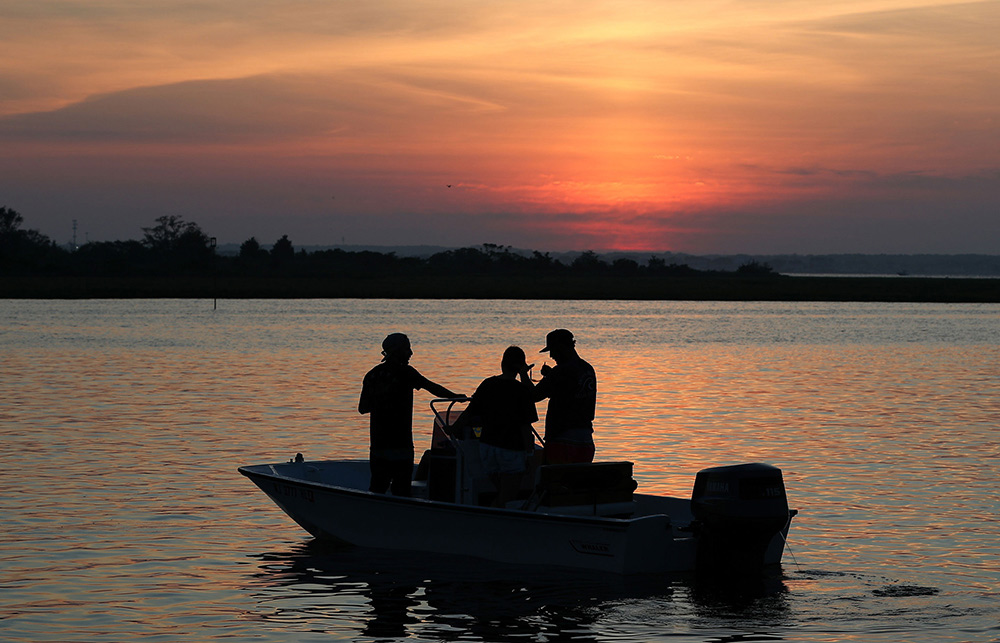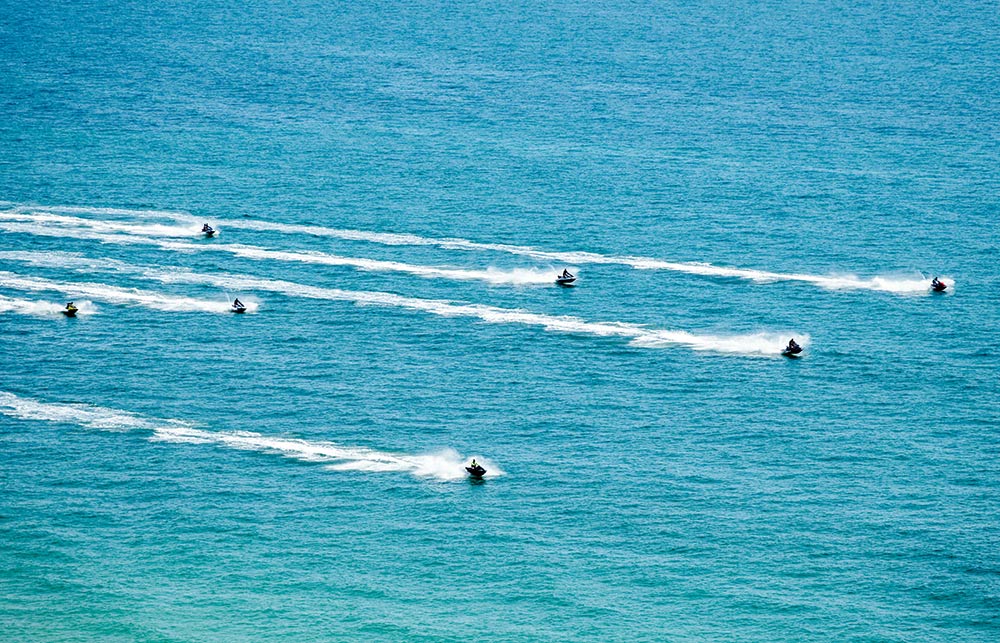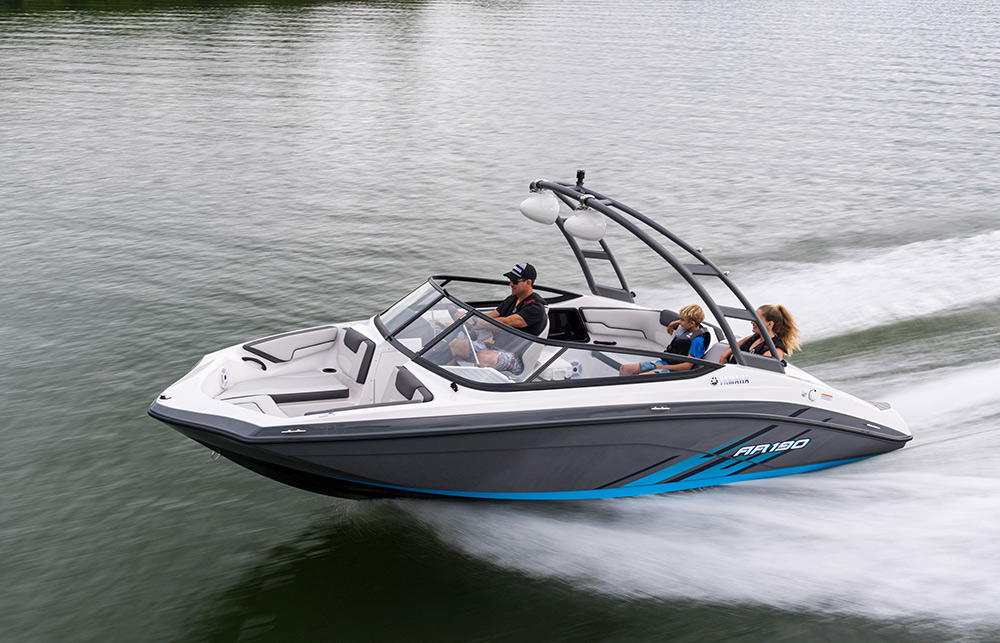泽西海岸的船坞空空荡荡,因为疫情而长期居家的人们蜂拥前往运河、小溪和河流出游,就像以前去迪士尼乐园或巴黎一样。

7月4日国庆节的周末,我和好朋友戴夫开车经过新泽西州布里克镇著名的船坞,这里是位于大西洋内陆半岛上的小村庄,其实就在纽约时代广场南边70英里。让我震惊的是,面前相当空旷,能看到康斯托克游艇销售和码头综合大楼的一部分,干涸的船坞里停着几艘船,只有几艘新船在售。“戴夫,这是不是说明,疫情严重冲击了水上运动?”我问道。“你在开玩笑吧?”戴夫反驳道。“冬天我把船停在康斯托克,每周都过来。当时到处都是新船,挤得人都走不动。我的船下水后,6月回去看了一眼,船坞里几乎空了。经理告诉我:‘全都卖完了。’”
布里克镇的划船热并非孤例,从佛罗里达州的沿海水道到密苏里州的奥扎克湖,再到华盛顿的普吉特湾,生活方式的变化正席卷全美。布里克镇人口7.5万,河流和运河密布。很多人一直居住于此,通勤到纽约市或费城上班,还有很多人只在周末和暑假前往休假。此处一直很适合划船,布里克镇成千上万的富裕家庭住在水边狭窄土地的大房子里,水边是一排排紧挨着的私人码头。随着疫情爆发,人们对海上休闲越发渴望。
“这里的人不去佛罗里达的主题公园,孩子们不玩足球和篮球,我也取消了阿拉斯加的行程。”康斯托克的副总裁唐•迪泽尔说,康斯托克是上世纪70年代初他家收购的产业,主要用雪松农场的木材造船。“在这里,如果不下水就很难赚钱。人们都厌倦了家里的四面墙。这是一种新认识,旅行房车行业也一样。”他指出,纽约和宾夕法尼亚州的“人口大量涌入”,要么在布里克镇买房子,要么在避暑别墅工作。“人们都有时间陪孩子一整天,所以纷纷选择划船,这也是社交隔离期间能享受的最有趣的事了。”迪泽尔说。“我们在这里发现了企业缺乏的增长动力,即年轻、首次尝试的客户激增。”水上项目逐渐变成了因为疫情而被憋疯的美国人的首选。
24岁的康拉德是我朋友戴夫的儿子,工作是市场经理,他打算买17英尺长的新船。康拉德想买自己的船,主要因为喜欢开父亲的海钓艇去位于近处巴内特湾附近的水道F-Cove,人们停好船,既能跟旁边船保持安全距离,还可以参与大型的浮动车尾聚会。从退休人员到大学生,各种人都在参与,还有些人放下救生橡皮艇,这样就能划着船到处跟朋友打招呼。
必须承认,我并不是航海爱好者,对划船的兴趣完全为了研究因为疫情而繁荣起来的这个产业。我对航海兴趣不大其实并不正常,因为我从小喊父亲“船长”,他是持有执照的“水手长”,一辈子在油轮上当大副。回到陆地以后,他把家里墙壁称为“舱壁”,把地板称为“甲板”。他给我这个不喜欢船的孩子起了个绰号:“水手长。”每当被水手长质问时,船长就回答说:“松一松,悠着点。”他在评论某个人的理由不太靠谱时会说:“他的水手袋没有打包好。”
总体来看,美国游艇业增长达到十多年来最高水平。代表船只和船舶发动机制造商的美国国家海洋制造商协会的统计数据显示,经济大衰退曾经重创休闲游艇业,2006年和2007年的年销售量超过30万台,到2009年年中到2014年年中,销量跌至低点,仅为18万艘左右。“大衰退对行业造成了严重打击。”新泽西州海洋贸易协会执行董事梅丽莎•丹科说。“20年里减少了10万艘注册船只,”下降幅度为40%。随着个人收入的强劲增长,股市上扬,2019年美国销售量逐渐回升至25万艘左右。
今年1月和2月,销售数字在2019年的强劲水平基础上继续上升。随后由于疫情导致的停产,4月和5月销售额下降了三分之一以上,为每月1.7万艘左右。5月交货达到了2.8万艘,创下2007年11月以来最高纪录。热门类别中,个人船艇(PWC)的销售额创下月度新高,6月个人船艇(PWC)同比猛增41%,5月喷气艇销量比去年高31%。“销量已经企稳,现在都是新买家推动的增长机会。”丹科说。

推动潮流
从雅马哈船艇腾飞的案例,可以看出新吸引力和新客户是如何推动休闲划船的。雅马哈船艇隶属美国雅马哈发动机公司,旗下生产和销售两条产品线都因为划船、个人船只和喷气艇市场的复苏而受益匪浅。负责销售和市场营销的布莱恩•塞蒂已经在雅马哈工作了22年。他解释说,雅马哈在佐治亚州和田纳西州的两家工厂生产WaveRunner品牌的个人船艇,也在美国销售雅马哈喷气艇。这两条生产线都针对首次购船者。WaveRunner是一种开放式的船,通常长度为11英尺,更类似水上摩托车,能承载一到三个人,坐在一个座位上。驾驶者可以在海浪飞沫中疾驰,后面还能拖着充气垫,带孩子们冲浪。WaveRunner的价格从6000美元到15000美元不等。
而喷气艇封闭式船只,体型则大得多,长度为19到27英尺,船内装有内型发动机,还装有从音响系统到淋浴和水上运动塔等多种便利设施。售价从3万元到13万元不等。“不管是WaveRunners和喷气艇,均为多功能设计,非常适合新的休闲需求。”塞蒂说。“可以乘WaveRunners和喷气艇钓鱼,也可以冲浪或滑行;如果是喷气艇,可以花一个星期在长岛湾或查尔斯湖巡游,拜访朋友,探寻美味。”平均而言,最近这两款产品的买家主要是40多岁左右的人。“通常在收入达到最高水平,有了孩子,买了一两辆车和一套房子之后购买,”塞蒂说。

多年来,雅马哈在个人船艇和喷气艇领域占据的市场份额遥遥领先。总体来看,相关类别占到动力船总销量三分之一左右。个人船艇市场每年约80000艘,雅马哈的WaveRunner占42%的份额,喷气艇业务则占十分之九,6000艘里占5500艘。自2014年以来,船艇销售量以每年5%左右的速度增长,超过全行业水平。“今年的开局不错,”塞蒂说。“1月和2月销售非常强劲。随后,3月下旬销量大幅下滑。当时经销商还不知道之后会失业60天。“塞蒂认为雅马哈应该为客户提供深入援助,“撑过未来60到90天,不至于让一整年的努力付诸东流。”
雅马哈的支持分为三部分。首先,为3月和4月的广告预算提供全额资金,确保经销商不会停掉广告。“我们承担了广告费。”塞蒂说。其次,雅马哈为经销商的客户提供无息融资,船只180天零首付,WaveRunners系列产品90天零首付。“撑到夏天就好了。”他告诉他们。第三,雅马哈免除了“地板”费,即之前向经销商收取船坞和展厅展出未售出船只的费用。
与此同时,雅马哈也在支持经销商继续争取客户,如今疫情改变了整个销售过程,之前是人与人见面实体销售,现在变为在线销售。塞蒂说:“以前的方式是,1月或2月参加大型船展,看到喜欢的船之后亲自坐在驾驶台旁体验,然后跟地区经销商碰面。到了春天,打电话或拜访经销商下单。”他说,很多客户会要求买之前试驾兜风。经销商们担心,原来客户都喜欢跟销售人员面对面,而现在销售点大多已经关门,买家会因此减少。“营销方式和顾客的购买方式完全变了。”他说。“我们帮经销商利用Zoom销售,提供视频介绍,还使用电子文档签署合同。突然间,顾客们对网上购物也很满意。”
业内所称的“旺季”,即2019年10月至今年6月销量大增期间,WaveRunner的销量从2.1万辆跃升至2.6万辆,较2018年至2019年同期增长23%,也创下新纪录。在喷气艇方面,从10月到6月,已经售出3630艘,比之前一季增加了1047架,增幅达29%。
在塞蒂看来,尽管3月出现下跌,本季销售仍然远超上一季,这证明了上升趋势(与作者不同)相当稳健并不“晕船”。“我们一直格外重视首次购买者,但现在买家越来越多,包括30多岁到40多岁的人。”他说。“这是新生需求,也是根本性的改变。船只行业将保持多年上升趋势,因为只要喜欢了水上休闲,就会一直喜欢。”他预测,在刚买第一艘船的家庭里,孩子们都会迷上划船的感觉。今年夏天,很多孩子每天钓鱼冲浪,而不是徒步露营或乘游轮旅行。“疫情期间,划船是最棒的居家度假方式。”塞蒂说。
他说,年轻的买家发现划船确实不错,能在水上玩更多时间。父母不再只是周末去湖边或海滨别墅,整个春天和夏天都能住在水边居家工作。“35岁的人可以花3万美元买艘19英尺的船,一周划三四天,一次6小时。”塞蒂说。“如果跟之前花4000美元买职业体育赛事两个赛季的门票相比,其实挺划算。”
我还采访了经销商,他们都证实了塞蒂的判断,现在网络购物确实占据了主导地位。“90天内网站流量增长了1000%。”MarineMax的Ozarks分公司总经理戴尔•劳说,MarineMax公司股票刚达到14年来高点。劳指出,销售额比去年增长了15%,完全由电商业务带动:“现在人们看到视频后,打电话给销售人员说:‘多介绍点这艘船的信息。’然后人们还没有试驾,网购的数量就已经创下纪录。”
劳补充说,“没有人想到会出现创纪录的复苏。”首次购买的人非常多,他很受鼓舞,但并不确定繁荣能持续多久。“谁知道人们能旅行之后会怎样?”他说。康斯托克的迪泽尔很乐观。“我们需要的就是新鲜血液,新买家进入填补衰老的一代。”他说。“现实恰是如此。之前人们的安排都跟着孩子的日程走。”他补充说。“现在,孩子都没有事做,所以大家有很多时间划船。我们卖的就是填补空闲的快乐。”听起来真是有趣,我真的很期待乘坐戴夫的船出海玩一趟。到时候我要站着驾驶台前,手握台克利鸡尾酒,讲述那一次我父亲的船遭遇飓风,海上波涛汹涌,马戏团的大象受惊从甲板一侧滑到另一边,差点把船弄沉的故事。(财富中文网)
译者:Feb
泽西海岸的船坞空空荡荡,因为疫情而长期居家的人们蜂拥前往运河、小溪和河流出游,就像以前去迪士尼乐园或巴黎一样。
7月4日国庆节的周末,我和好朋友戴夫开车经过新泽西州布里克镇著名的船坞,这里是位于大西洋内陆半岛上的小村庄,其实就在纽约时代广场南边70英里。让我震惊的是,面前相当空旷,能看到康斯托克游艇销售和码头综合大楼的一部分,干涸的船坞里停着几艘船,只有几艘新船在售。“戴夫,这是不是说明,疫情严重冲击了水上运动?”我问道。“你在开玩笑吧?”戴夫反驳道。“冬天我把船停在康斯托克,每周都过来。当时到处都是新船,挤得人都走不动。我的船下水后,6月回去看了一眼,船坞里几乎空了。经理告诉我:‘全都卖完了。’”
布里克镇的划船热并非孤例,从佛罗里达州的沿海水道到密苏里州的奥扎克湖,再到华盛顿的普吉特湾,生活方式的变化正席卷全美。布里克镇人口7.5万,河流和运河密布。很多人一直居住于此,通勤到纽约市或费城上班,还有很多人只在周末和暑假前往休假。此处一直很适合划船,布里克镇成千上万的富裕家庭住在水边狭窄土地的大房子里,水边是一排排紧挨着的私人码头。随着疫情爆发,人们对海上休闲越发渴望。
“这里的人不去佛罗里达的主题公园,孩子们不玩足球和篮球,我也取消了阿拉斯加的行程。”康斯托克的副总裁唐•迪泽尔说,康斯托克是上世纪70年代初他家收购的产业,主要用雪松农场的木材造船。“在这里,如果不下水就很难赚钱。人们都厌倦了家里的四面墙。这是一种新认识,旅行房车行业也一样。”他指出,纽约和宾夕法尼亚州的“人口大量涌入”,要么在布里克镇买房子,要么在避暑别墅工作。“人们都有时间陪孩子一整天,所以纷纷选择划船,这也是社交隔离期间能享受的最有趣的事了。”迪泽尔说。“我们在这里发现了企业缺乏的增长动力,即年轻、首次尝试的客户激增。”水上项目逐渐变成了因为疫情而被憋疯的美国人的首选。
24岁的康拉德是我朋友戴夫的儿子,工作是市场经理,他打算买17英尺长的新船。康拉德想买自己的船,主要因为喜欢开父亲的海钓艇去位于近处巴内特湾附近的水道F-Cove,人们停好船,既能跟旁边船保持安全距离,还可以参与大型的浮动车尾聚会。从退休人员到大学生,各种人都在参与,还有些人放下救生橡皮艇,这样就能划着船到处跟朋友打招呼。
必须承认,我并不是航海爱好者,对划船的兴趣完全为了研究因为疫情而繁荣起来的这个产业。我对航海兴趣不大其实并不正常,因为我从小喊父亲“船长”,他是持有执照的“水手长”,一辈子在油轮上当大副。回到陆地以后,他把家里墙壁称为“舱壁”,把地板称为“甲板”。他给我这个不喜欢船的孩子起了个绰号:“水手长。”每当被水手长质问时,船长就回答说:“松一松,悠着点。”他在评论某个人的理由不太靠谱时会说:“他的水手袋没有打包好。”
总体来看,美国游艇业增长达到十多年来最高水平。代表船只和船舶发动机制造商的美国国家海洋制造商协会的统计数据显示,经济大衰退曾经重创休闲游艇业,2006年和2007年的年销售量超过30万台,到2009年年中到2014年年中,销量跌至低点,仅为18万艘左右。“大衰退对行业造成了严重打击。”新泽西州海洋贸易协会执行董事梅丽莎•丹科说。“20年里减少了10万艘注册船只,”下降幅度为40%。随着个人收入的强劲增长,股市上扬,2019年美国销售量逐渐回升至25万艘左右。
今年1月和2月,销售数字在2019年的强劲水平基础上继续上升。随后由于疫情导致的停产,4月和5月销售额下降了三分之一以上,为每月1.7万艘左右。5月交货达到了2.8万艘,创下2007年11月以来最高纪录。热门类别中,个人船艇(PWC)的销售额创下月度新高,6月个人船艇(PWC)同比猛增41%,5月喷气艇销量比去年高31%。“销量已经企稳,现在都是新买家推动的增长机会。”丹科说。
迈阿密海滩,个人艇在比赛。“没有人想到会出现创纪录的复苏。”一位经销商谈到销售时说。“谁知道人们能旅行之后会怎样?我认为涨势不会持续多年。”
推动潮流
从雅马哈船艇腾飞的案例,可以看出新吸引力和新客户是如何推动休闲划船的。雅马哈船艇隶属美国雅马哈发动机公司,旗下生产和销售两条产品线都因为划船、个人船只和喷气艇市场的复苏而受益匪浅。负责销售和市场营销的布莱恩•塞蒂已经在雅马哈工作了22年。他解释说,雅马哈在佐治亚州和田纳西州的两家工厂生产WaveRunner品牌的个人船艇,也在美国销售雅马哈喷气艇。这两条生产线都针对首次购船者。WaveRunner是一种开放式的船,通常长度为11英尺,更类似水上摩托车,能承载一到三个人,坐在一个座位上。驾驶者可以在海浪飞沫中疾驰,后面还能拖着充气垫,带孩子们冲浪。WaveRunner的价格从6000美元到15000美元不等。
而喷气艇封闭式船只,体型则大得多,长度为19到27英尺,船内装有内型发动机,还装有从音响系统到淋浴和水上运动塔等多种便利设施。售价从3万元到13万元不等。“不管是WaveRunners和喷气艇,均为多功能设计,非常适合新的休闲需求。”塞蒂说。“可以乘WaveRunners和喷气艇钓鱼,也可以冲浪或滑行;如果是喷气艇,可以花一个星期在长岛湾或查尔斯湖巡游,拜访朋友,探寻美味。”平均而言,最近这两款产品的买家主要是40多岁左右的人。“通常在收入达到最高水平,有了孩子,买了一两辆车和一套房子之后购买,”塞蒂说。
2021款雅马哈AR-190。雅马哈船艇公司是日本雅马哈发动机株式会社的子公司,生产和销售两条产品线都因为划船、个人船只和喷气艇市场复苏而受益匪浅。
多年来,雅马哈在个人船艇和喷气艇领域占据的市场份额遥遥领先。总体来看,相关类别占到动力船总销量三分之一左右。个人船艇市场每年约80000艘,雅马哈的WaveRunner占42%的份额,喷气艇业务则占十分之九,6000艘里占5500艘。自2014年以来,船艇销售量以每年5%左右的速度增长,超过全行业水平。“今年的开局不错,”塞蒂说。“1月和2月销售非常强劲。随后,3月下旬销量大幅下滑。当时经销商还不知道之后会失业60天。“塞蒂认为雅马哈应该为客户提供深入援助,“撑过未来60到90天,不至于让一整年的努力付诸东流。”
雅马哈的支持分为三部分。首先,为3月和4月的广告预算提供全额资金,确保经销商不会停掉广告。“我们承担了广告费。”塞蒂说。其次,雅马哈为经销商的客户提供无息融资,船只180天零首付,WaveRunners系列产品90天零首付。“撑到夏天就好了。”他告诉他们。第三,雅马哈免除了“地板”费,即之前向经销商收取船坞和展厅展出未售出船只的费用。
与此同时,雅马哈也在支持经销商继续争取客户,如今疫情改变了整个销售过程,之前是人与人见面实体销售,现在变为在线销售。塞蒂说:“以前的方式是,1月或2月参加大型船展,看到喜欢的船之后亲自坐在驾驶台旁体验,然后跟地区经销商碰面。到了春天,打电话或拜访经销商下单。”他说,很多客户会要求买之前试驾兜风。经销商们担心,原来客户都喜欢跟销售人员面对面,而现在销售点大多已经关门,买家会因此减少。“营销方式和顾客的购买方式完全变了。”他说。“我们帮经销商利用Zoom销售,提供视频介绍,还使用电子文档签署合同。突然间,顾客们对网上购物也很满意。”
业内所称的“旺季”,即2019年10月至今年6月销量大增期间,WaveRunner的销量从2.1万辆跃升至2.6万辆,较2018年至2019年同期增长23%,也创下新纪录。在喷气艇方面,从10月到6月,已经售出3630艘,比之前一季增加了1047架,增幅达29%。
在塞蒂看来,尽管3月出现下跌,本季销售仍然远超上一季,这证明了上升趋势(与作者不同)相当稳健并不“晕船”。“我们一直格外重视首次购买者,但现在买家越来越多,包括30多岁到40多岁的人。”他说。“这是新生需求,也是根本性的改变。船只行业将保持多年上升趋势,因为只要喜欢了水上休闲,就会一直喜欢。”他预测,在刚买第一艘船的家庭里,孩子们都会迷上划船的感觉。今年夏天,很多孩子每天钓鱼冲浪,而不是徒步露营或乘游轮旅行。“疫情期间,划船是最棒的居家度假方式。”塞蒂说。
他说,年轻的买家发现划船确实不错,能在水上玩更多时间。父母不再只是周末去湖边或海滨别墅,整个春天和夏天都能住在水边居家工作。“35岁的人可以花3万美元买艘19英尺的船,一周划三四天,一次6小时。”塞蒂说。“如果跟之前花4000美元买职业体育赛事两个赛季的门票相比,其实挺划算。”
我还采访了经销商,他们都证实了塞蒂的判断,现在网络购物确实占据了主导地位。“90天内网站流量增长了1000%。”MarineMax的Ozarks分公司总经理戴尔•劳说,MarineMax公司股票刚达到14年来高点。劳指出,销售额比去年增长了15%,完全由电商业务带动:“现在人们看到视频后,打电话给销售人员说:‘多介绍点这艘船的信息。’然后人们还没有试驾,网购的数量就已经创下纪录。”
劳补充说,“没有人想到会出现创纪录的复苏。”首次购买的人非常多,他很受鼓舞,但并不确定繁荣能持续多久。“谁知道人们能旅行之后会怎样?”他说。康斯托克的迪泽尔很乐观。“我们需要的就是新鲜血液,新买家进入填补衰老的一代。”他说。“现实恰是如此。之前人们的安排都跟着孩子的日程走。”他补充说。“现在,孩子都没有事做,所以大家有很多时间划船。我们卖的就是填补空闲的快乐。”听起来真是有趣,我真的很期待乘坐戴夫的船出海玩一趟。到时候我要站着驾驶台前,手握台克利鸡尾酒,讲述那一次我父亲的船遭遇飓风,海上波涛汹涌,马戏团的大象受惊从甲板一侧滑到另一边,差点把船弄沉的故事。(财富中文网)
译者:Feb
The Jersey Shore’s empty boatyards bear witness that locked-down leisure-seekers are making outings on our canals, creeks, and rivers the new jaunts to Disney World or Paris.
Over July Fourth weekend, my great friend Dave and I were driving past a boatyard that’s a landmark in Brick Township, N.J., a hamlet on a peninsula just inland from the Atlantic, and around 70 miles south of Times Square. I was shocked to see a mainly barren expanse––part of the creek-front Comstock Yacht Sales & Marina complex––dotted with just a couple of boats in dry dock, and featuring only a few new craft for sale. “Dave, does this mean the pandemic is killing boating?” I inquired. “Are you kidding?” riposted Dave. “I keep my boat at Comstock in the winter, and I visited every week. The place was so chock-full of new boats you couldn’t walk between them. After I put my Blackfin in the water, I go back in June, and the yard’s almost empty. The manager tells me, ‘Everything just sold out.’”
The boating surge in Brick Township illustrates a shift in lifestyles that’s sweeping America from Florida’s Intracoastal Waterway to Missouri’s Lake of the Ozarks to Washington’s Puget Sound. Brick Township, population 75,000, is honeycombed with rivers and canals. Many of its residents live there full-time and commute to work in New York City or Philadelphia, while a large portion come down on weekends and for summer vacations. This was always a boating haven—thousands of Brick Township’s mainly affluent families live on the water in large homes clustered on narrow lots, their private docks lined up cheek by jowl. But the COVID-19 outbreak has taken the craving for leisure on the seas to a whole new level.
“People from here aren’t going to Florida theme parks; there’s no soccer or basketball for the kids; I canceled a cruise to Alaska,” says Don Ditzel, vice president of Comstock, a property his family bought in the early 1970s to build vessels from wood harvested from their cedar farm. “You can't swing a purse without hitting the water here. People are tired of the four walls of their houses. It’s an awakening, the same thing that’s happening with RVs.” He notes “a huge influx of people” from New York and Pennsylvania who are either buying houses in Brick Township or working full-time from their summer homes there. “They have all day to do things with their kids, so they’ve turned to boating, which is about the most fun you can have while social distancing,” says Ditzel. “We’re seeing just the growth impetus the business has been lacking, a jump in younger, first-time customers.” The water is becoming the chief refuge for stir-crazy Americans.
My friend David’s son Conrad, a 24-year-old marketing manager, is shopping for a new, 17-foot fishing boat. Conrad wants his own craft in part because he enjoys taking his dad’s Blackfin Sportfisherman to F-Cove, a waterway off the nearby Barnegat Bay where people beach their boats and join in a big floating tailgate party while typically keeping a safe distance from the vessel parked alongside. The boaters, who encompass everyone from retirees to college kids, even drop rubber rafts so that they can row around greeting friends.
This writer must confess that he’s anything but nautical, and that his interest in boating arises strictly from studying the industries prospering from how Americans are coping with the pandemic. That I’ve never found my sea legs is surprising, since my father, whom I called “Skipper,” was a licensed "master mariner" who spent his career as a first mate on oil tankers, and while on land, called our home’s walls “the bulkhead” and the floors “the deck.” He dubbed this boat-shy offspring, "the bosun." When challenged by the bosun, Skipper would respond, “Slack away easy.” A typical description of someone whose reasoning he found less than sound: “He’s not shipping with a full seabag.”
Overall, America’s boating business is showing the strongest growth in over a decade. The Great Recession hammered leisure craft, pummeling units sold from over 300,000 a year in 2006 and 2007 to a low of around 180,000 from mid-2009 to mid-2014, according to statistics from the National Marine Manufacturers Association that represents makers of boats and marine engines. "The Great Recession hit the industry hard," says Melissa Danko, executive director of the Marine Trades Association of New Jersey. “We went down by 100,000 registered boats in two decades,” a drop of 40%. As personal incomes began a strong run, and the stock market ascended, national sales gradually recovered to the 250,000 range in 2019.
In January and February, the numbers continued their rise from strong 2019 levels. Then, the COVID-driven shutdown hammered sales by over one-third in April and May to around 17,000 a month. Talk about a V––deliveries took a moonshot in May to around 28,000, the best number since November of 2007. In hot categories, sales hit record monthly highs, with personal watercraft, or PWC, jumping 41% in June over last year, and for May, jet boats beating last year’s number by 31%. “We’d stabilized, but what we’re seeing now is a growth opportunity driven by new buyers,” says Danko.
Powering a trend
The takeoff at Yamaha WaterCraft offers an onboard view of the fresh allure and new customers powering leisure boating. Yamaha WaterCraft, a division of Yamaha Motor Corp. USA, manufactures and sells the two product lines that have benefited most from the romance with boating, personal watercraft and jet boats. Heading sales and marketing is Bryan Seti, a 22-year Yamaha veteran. Yamaha makes its PWCs under the WaveRunner brand, and its Yamaha jet boats sold in the U.S., he explains, at two plants in Georgia and Tennessee. The two lines are both aimed at first-time buyers. The WaverRunners are open vessels, typically 11 feet in length, that in some ways resemble motorcycles on the water, carrying one to three people, all riding on a single seat. The drivers love speeding across the foam, often towing kids on inflatables for tubing. WaveRunner prices run from $6,000 to $15,000.
Jet boats are much bigger, enclosed craft measuring 19 to 27 feet, featuring internal-propulsion motors built into the hull of the boat, and lots of amenities from sound systems to showers and water sports towers. Prices range from $30,000 to $130,000. “Both the WaveRunners and jet boats are versatile, so they’re ideally suited to the new quest for leisure,” says Seti. "You can fish with WaveRunners and jet boats; use them for tubing or wakesurfing; and for jet boats, spend a week cruising the Long Island Sound or Lake Charles to visit friends and stop at restaurants.” On average, buyers until recently have mainly been in their mid-to late forties for both products. “People usually buy after they’ve hit peak earnings years, had kids, and bought a car or two, and a house,” says Seti.
For years, Yamaha has held far and away top market share in both PWCs and jet boats. All told, those categories account for around one-third of all powerboat sales. Yamaha’s WaveRunner holds 42% of the approximately 80,000 annual PWC market, and sells nine in 10, or 5,500 of 6,000 new jet boats that hit the water each year. Since 2014, unit sales have been growing at around 5% a year, outpacing the overall industry. "This year got off to a great start," says Seti. “January and February were very strong months. Then sales fell sharply in late March. Dealers we sell to didn’t know if they’d be out of work in 60 days.” Seti reckoned that Yamaha needed to provide extensive aid to its customers “as a bridge for the next 60 to 90 days so that a whole year didn’t get wiped out.”
Yamaha’s support came in three parts. First, it made sure dealers didn’t stop running ads by covering 100% of their advertising budgets for March and April. “We picked up the tab on ads,” Seti remarks. Second, Yamaha provided the dealers’ customers with financing at 0% interest and no down payment for 180 days for boats and 90 days for WaveRunners. “The summer’s on us,” he told them. Third, Yamaha waived “flooring” fees, the interest it charges dealers for unsold boats on display in their yards and showrooms.
At the same time Yamaha’s backing encouraged dealers to keep reaching for customers, the pandemic was transforming the entire sales process from person to person and kicking the hull to digital. Says Seti: “The old way was, you come to a big boat show in January or February, see one you love and sit at the controls, and meet the dealer in your area selling that model. And in the spring, call or visit the dealer to put in an order.” Many customers, he says, demanded that the dealer take them for a spin before buying. Dealers fretted that customers traditionally liked to meet face to face with a salesperson, and because their offices were mostly closed, buyers would dwindle. “Then, the way they marketed and the way customers purchased totally changed,” he says. “We helped dealers get a lot better at selling over Zoom and providing video tours, and using e-docs for signing the contracts. Suddenly, customers became comfortable buying online.”
For what the industry calls “the season,” the peak months from October 2019 to June of this year, sales of WaveRunners have jumped from 21,000 to 26,000, marking an increase of 23% over the same period spanning 2018 to 2019 and establishing a new record. As for jet boats, its dealers have sold 3,630 units from October through June, 1,047 or 29% more than in the previous season.
For Seti, that this season beats last season by a wide margin, despite the fall in March, proves that the uptrend (unlike the author) has sea legs. “We always focused on first-time buyers, but now we’re seeing a lot more of them, including people in their late-thirties to mid-forties,” he says. “That’s fresh demand. This is a fundamental change. It will spur boating for many years, because once the water life is in your DNA, it stays there.” He predicts that the kids whose families just bought their first craft will get hooked on the romance of boating. Many children will go fishing and surfing every day this summer instead of trekking to camp or going on cruises. "In the pandemic, boating is ultimate staycation," says Seti.
Younger buyer, he says, are finding that boating is a good deal because they now have a lot more time to spend on the water. Instead of visiting the lake or shore house only on weekends, the parents are living there all spring and summer, and working from home. “Someone who’s 35 can pay $30,000 for a 19-footer and take it out three or four days a week, six hours at a time," says Seti. "That’s a bargain when you consider that they used to spend $4,000 for two season tickets for pro sporting events.”
I also interviewed dealers, and they confirmed Seti’s view that Internet shopping has taken charge––in a flash. “Our web traffic is up 1,000% in 90 days,” says Dale Law, general manager at the Lake of the Ozarks branch of MarineMax, a publicly traded boat seller whose stock just hit a 14-year high. Law notes that sales are running 15% ahead of last year, and it’s all about e-commerce: “People watch videos then call a salesperson and say, ‘Tell me more about the boat.’ But then they’re buying in record numbers online, without even test-driving.”
Law adds that “no one could have predicted this record resurgence.” He’s encouraged by a surge in first-time buyers, but remains unsure how long the boom will last. “Who knows what will happen when people get back to traveling?” he says. Ditzel of Comstock, back in Brick Township, is upbeat. “What we needed was new blood to make up for the boaters who are aging out faster than new buyers,” he says. “And that’s happening. It used to be that what people did was dominated by their kids’ schedules,” he adds. “Now, their kids are unscheduled, and they have lots of time for boating. We’re selling fun to fill that time.” Sounds so good I’m actually looking forward to an outing on Dave’s Blackfin. I’ll be the one on the fly bridge holding a daiquiri, and telling tales about the time a cargo of circus elephants, bowled over in a hurricane and careening across the deck, nearly capsized Skipper’s tanker into a boiling sea.






